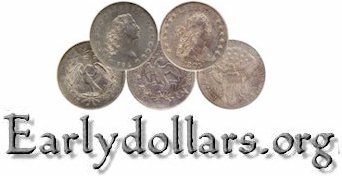

|
Production of Draped Bust dollars dated 1799 represented a further increase in mintage from 1798, and, again, a large number of dies were needed. Mintage of 1799 dollars ultimately employed 11 known different obverse dies and 16 known different reverse dies. These combined to create 22 different individual die varieties and multiple Redbook types. The Redbook categorizes these by characteristics of the date, the number of stars on the reverse, and by the arrangement of stars of the obverse. The combinations of these features create six different Redbook types. The earliest obverse die displays a date plainly showing the final “9” punched over top of a previously punched numeral “8.” Apparently, this obverse die had been prepared originally with the “1798” date, but was not used for coinage that year. When dollar production commenced in 1799, Mint employees simply modified the die to show “1799,” rather than scrapping it and making a completely new obverse die. Traces of the original numeral “8” are quite visible, even to the unaided eye on this “over date.” The next obverse die used was also a carryover from prior years. In this case, however, the die had not been finished in the date area - missing the final date digit. When placed into service in 1799, this die was finished by punching in the needed final “9”; however, it was punched too low and slanted too far to the right, creating a most “irregular” appearance. The remaining obverse dies for the year all bear a date of more normal appearance. |
|
|
|
|
|
1799/8 Overdate |
1799 Irregular Date |
|
|
|
|
1799 Normal Date |
|
|
One of the reverse dies of 1799 shows an odd arrangement of stars. Apparently, the mint employee was distracted and accidentally punched 15 stars above the eagle, rather than the normal 13. To cover this blunder, the first and last clouds were expanded greatly, mostly hiding the stars at the top left and top right. Close inspection reveals two points of each star - all that remains from the erroneous extra stars. All other reverse dies of the year display the normal 13 stars. The “15 Star” and “13 Star” reverses were combined with both of the abnormally-dated obverses - creating four of the Redbook varieties. With all of its unusual features, the 1799/8 15 Star variety is immensely popular. An estimated 1,000 specimens still exist. The 1799/8 13 Star variety is also quite popular. There are an estimated 1,000 specimens of this variety still in existence also. The Irregular Date varieties are not as well known as the Overdate varieties, but they are actually quite a bit scarcer. Approximately 500 specimens remain of the 1799 Irregular Date 15 Star variety, and approximately 400 specimens remain of the 1799 Irregular Date 13 Star variety. |
|
|
|
|
|
15 Star Reverse |
|
|
|
|
|
13 Star Reverse |
|
|
One particularly unusual variety of 1799 dollar exhibits an odd arrangement of the stars on the obverse. On this variety the stars are arranged with 8 to the left and 5 to the right, in contrast to the normal 7x6 star arrangement used on every other variety of Draped Bust Large Eagle dollar dated from 1798 through 1803. The unusual arrangement of stars makes this variety very popular with collectors. An estimated 700 specimens of the 8x5 stars variety are thought to remain in existence. |
|
|
|
|
|
8x5 Stars obverse |
7x6 Stars obverse |
|
Beyond the distinctive features recognized in the Redbook, certain Draped Bust dollars of 1799 also display other very distinctive features on their reverses. In addition to the 15 Star and normal 13 Star reverses, the 1799/8 Overdate obverse was also combined with a second distinctive 13 Star reverse — this one showing prominent die crumbling at the “I” in “AMERICA.” |
|
|
|
|
|
13 Star — Crumbled I reverse |
|
|
|
|
|
13 Star — Normal reverse |
|
|
In addition to the 15 Star and normal 13 Star reverses, the 1799 Irregular date obverse was also combined with a second distinctive 13 Star reverse - this one showing the distinctive line star patterned “Reverse of 1798.” |
|
|
|
|
|
13 Star — Reverse of 1798 |
|
|
|
|
|
13 Star — Normal reverse |
|
|
The majority of 1799 reverse dies exhibit the motto “E PLURIBUS UNUM” using a smaller lettered font that had been previously used for the 1798 reverse dies. A couple 1799 reverses, however, use a larger font - which became the standard in 1800. |
|
|
|
|
|
Large Motto — Reverse of 1800 |
|
|
|
|
|
Small Motto — Normal Reverse |
|
|
The majority of 1799 reverses display 5 berries on the olive branch in the eagle’s left (viewer’s right) claw. However, due to progressive polishing of one reverse die, the berries were inadvertently removed. While not a design intended by the Mint engravers, the “No Berries” reverse is quite distinctive and very popular with collectors. |
|
|
|
|
|
No Berries reverse |
Normal reverse |